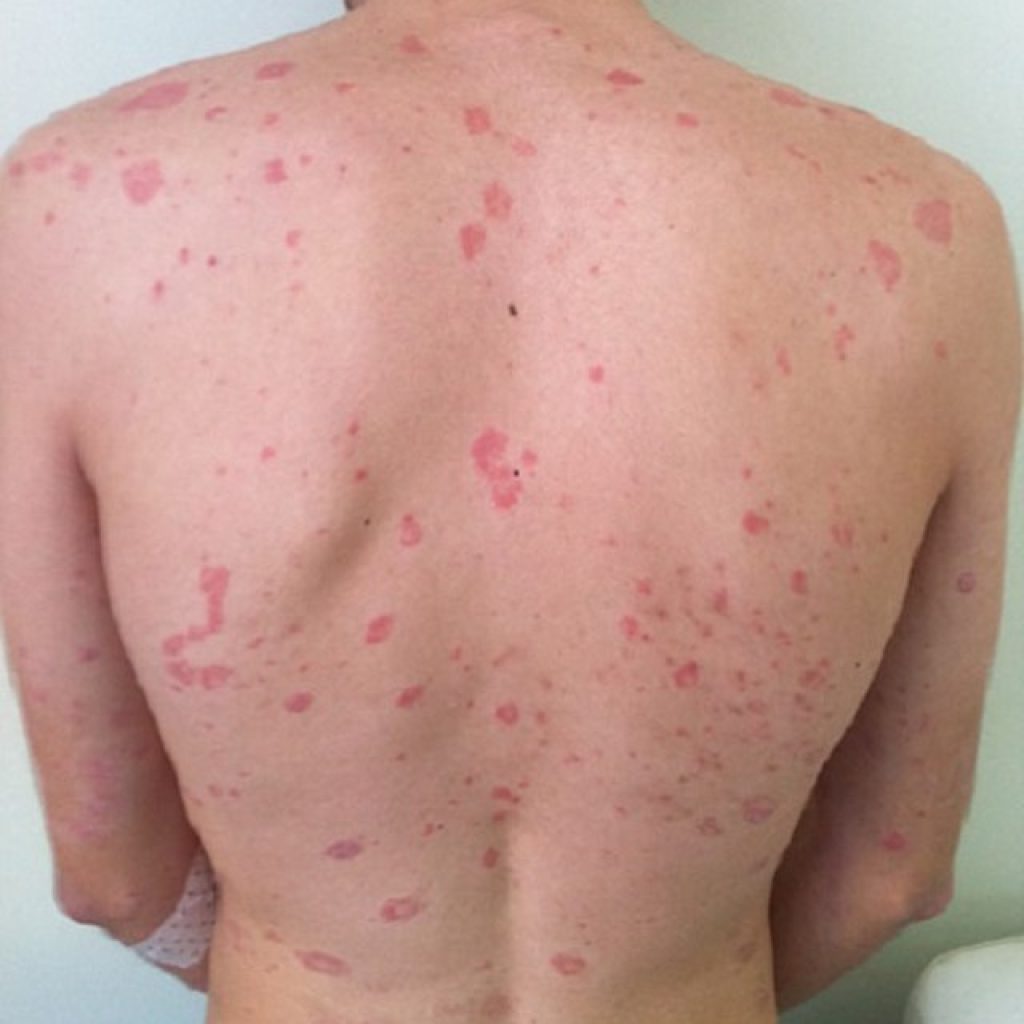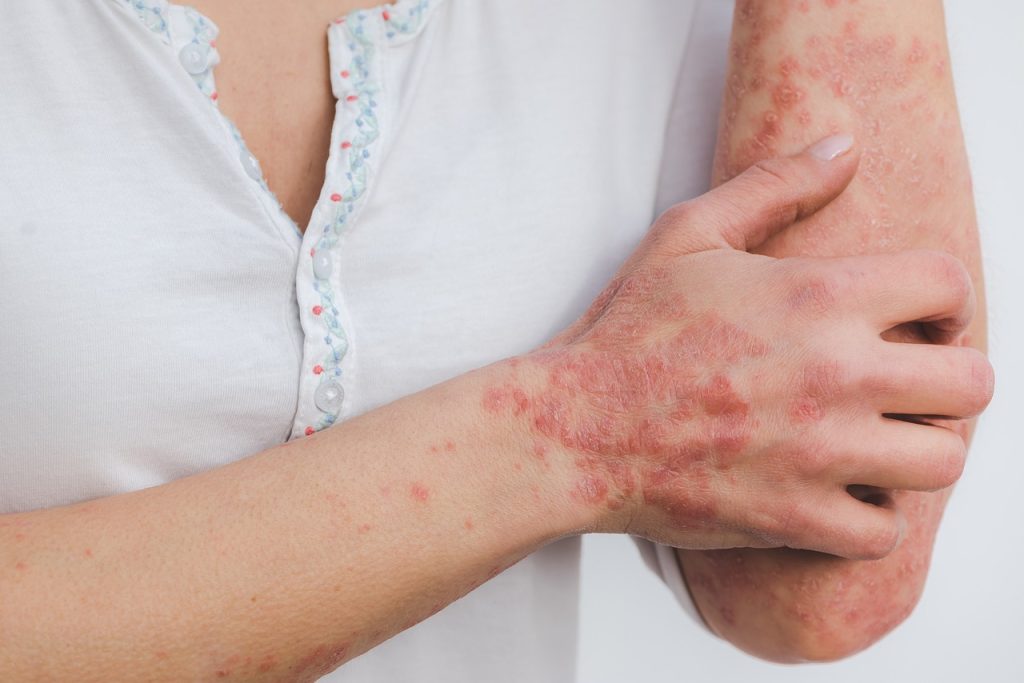Psoriasis is much more than a skin condition. Its effects challenge both physical and mental wellbeing, putting a strain on quality of life.
Identifiable by its hallmark red, raised, scale-like patches, over one million Canadians are affected and strive for relief. Patches aren’t merely a cosmetic nuisance that can be discreetly hidden away with some strategic makeup – they can itch and/or hurt. With irritation, patches can also blister or bleed.
Large or small patches can develop anywhere on the body, but they most commonly appear on the elbows, knees, scalp, chest, and lower back.

Usually, psoriasis waits to strike until you’re an adult, but on occasion, it can develop in childhood. Once psoriasis develops, it’s a lifelong companion, so it is imperative to learn how to live with it.
As of now, we’re still waiting on a cure but there are many treatment options available in Canada. It’s possible to achieve remission from the condition for months or years at a time.
Signs and Symptoms
The Canadian Dermatology Association lists symptoms as:
- Red to violet elevated areas of skin (plaques), usually covered with silvery-white scales
- Scaly plaques on the scalp, or shiny patches on the genitals or in the skin folds
- Itching and skin pain, sometimes severe
- Joint pain, swelling or stiffness in 1/3 of psoriasis patients who have psoriatic arthritis
- Nail abnormalities including nail pits, lifting of the nail, or thickening of the nail
While the exact cause is still unknown, an overactive immune system can explain both the internal and external symptoms. Genetics also play a major a role. Ask your family if there is a history of psoriasis.
Types of Psoriasis
There are nine different kinds of psoriasis, all with different symptoms, but only one kind is particularly common. Up to 90 per cent of people who develop psoriasis are diagnosed with plaque psoriasis.
Described above, plaque psoriasis looks a bit different depending on skin tone. “On Caucasian skin, plaques typically appear as raised, red patches covered with a silvery white buildup of dead skin cells or scale. On skin of color, the plaques may appear darker and thicker and more of a purple or grayish color or darker brown,” writes the National Psoriasis Foundation.
It’s important to note that you can develop multiple kinds of psoriasis at a time. Other types are:
- Guttate psoriasis
- Pustular psoriasis
- Inverse psoriasis
- Erythrodermic psoriasis
- Psoriatic Arthritis
Guttate psoriasis is the second most common form and is often triggered by a strep throat infection. While symptoms may go away without treatment and may only show up once if you’re lucky, the condition can become chronic or develop into plaque psoriasis.
Talk to your doctor at the onset of symptoms to learn the best way forward.
Psoriasis and Overall Health
Another form that is not always considered psoriasis, psoriatic arthritis develops in about 30 per cent of people with psoriasis. As an auto-immune disease, psoriasis can attack healthy cells, both on and under your skin. This inflammation can mimic the effects of arthritis or turn into full blown psoriatic arthritis.
Arthritis can be debilitatingly painful and the added stiffness does no favours for your joints.
“Having psoriasis may increase the risk of developing other chronic systemic diseases, including heart attack and stroke, diabetes, cancer, and liver disease,” writes the Canadian Dermatology Association.
Mental health is also commonly affected. People with psoriasis have an increased risk of mental illness including depression, anxiety, and suicidal thoughts.
Treatment Options
With many different forms of treatment available, dermatologists will usually combine different therapies to give you the best chance at relief.
Topical treatments tend to be the first line of defense against psoriasis. Best for mild conditions, these treatments may not be effective against more severe symptoms.
Topical: Usually covered by Medicare.
- Topical corticosteroids (most effective in category)
- Vitamin D3 analogues
- Retinoids
- Phosphodiesterase 4 inhibitors
- Calcineurin inhibitors (off-label)
- Anthralin
- Coal tar
Best for moderate to severe psoriasis, oral medications are usually used to treat widespread symptoms. Some of these medications may also be available as an infusion or injection.
Oral: Usually covered by Medicare.
- Methotrexate
- Acitretin
- Cyclosporine
- Apremilast
- Deucravacitinib
Biologics are a new form of treatment that are making their way into the limelight. They block specific inflammation pathways that are affected by psoriasis. This treatment is best for those experiencing severe symptoms.
Biologics: Only covered under medicare with special authorization based on strict criteria. Your doctor may have to apply for it.
- Tumor Necrosis Factor-alpha (TNF-alpha) Inhibitors
- Interleukin 12 and 23 (IL-12/23) Inhibitors
- Interleukin 17 (IL-17) Inhibitors
- Interleukin 23 (IL-23) Inhibitors
- Interleukin 36 (IL-36) Pathway Inhibitors
- T-Cell Inhibitors
An expensive undertaking, biologics can be incredibly effective, but ranging between $10,000 to $30,000 per year, they may not be your first choice.
Although Medicare may cover a portion for psoriasis treatment, a large chunk will still have to be paid out-of-pocket.
Light Therapy: Not covered by Medicare.
- Narrow-band/Broad-band UVB phototherapy
- UVA (PUVA)
At-home units can range in cost anywhere from $190 to upwards of $6,000. Talk to your doctor about the unit you want to buy to ensure effectiveness.
Treating Psoriasis With UVB Light Therapy
Sunbathing is by far the cheapest treatment option available. Free of charge, you can sit outside letting the rays of warmth wash over you.
UVB rays are effective in slowing the growth of psoriasis affected cells, aiding in a slight reprieve from symptoms. UVA rays are not as productive.
If you plan on going outside, sunscreen is a must. Some psoriasis medications can increase sunlight sensitivity and chance of sunburn.
Natural sunlight, as helpful as it is, is not as effective as light therapy devices. Technology can isolate and concentrate UVB rays on problem areas with more control and finesse. Used properly, there is little risk of sunburn and there is no evidence that it increases risk of melanoma.
You can buy light therapy devices for at home use, but you need a prescription from a dermatologist so they can teach you how to use it effectively to treat symptoms.
The National Psoriasis Foundation lists the differences between Narrow and Broad-band UVB phototherapy:
- Narrow-band UVB light bulbs release a smaller range of ultraviolet light
- Narrow-band UVB may clear psoriasis faster and produce longer remissions
- Narrow-band UVB may require fewer treatments per week
Broad-band therapy is best for widespread symptoms which would be difficult to treat with a Narrow-band light.
How to Use UVA
UVA alone is ineffective against psoriasis. When paired with psoralen, a light-sensitizing agent, UVA light can slow down the rapid cell growth that causes the plaques to appear. Results will vary from person to person.
Do not, I repeat, do not use a tanning bed for light treatment. It will be ineffective as the majority of rays are UVA, not UVB. It will only serve to raise your risk of melanoma by 59 per cent.
Psoriasis may be a lifelong companion, but that doesn’t mean you need to be a good host. Now that you’re armed with knowledge, take back your power and talk to your doctor about how to find relief.
~ Read more from The Health Insider ~
- The Affordable Superfood Canadians OverlookPacked with protein, fibre and key nutrients, beans are a budget-friendly way to boost health and support local farmers.
- Canada Authorizes First-Ever Oral Treatment for Postpartum DepressionCanada approves ZURZUVAE, the first oral PPD pill. This breakthrough 14-day oral therapy aims to elevate the standard of maternal mental health care.
- The Host Survival Guide: How to Set Boundaries & Delegate for a Stress-Free HolidayStop stressing! This guide offers actionable mental health strategies for hosts, including expert tips on setting boundaries, delegating tasks, and mastering advanced party prep.
- Optometrist vs. Ophthalmologist: Who to See, When and What Your Province Actually CoversStop guessing! This essential guide clarifies the roles of optometrists, ophthalmologists, and opticians, details provincial coverage for you, and sets your eye exam schedule.
- In-Flight & Holiday Comfort: Essential Gear for Stress-Free TravelFrom travel pillows to compression socks, here are the smartest comfort tools to stay rested and stress-free on flights and holiday visits.
- Ozempic, Wegovy and Mounjaro Are Changing Our Food ChoicesAppetite-suppressing GLP-1 medications may be changing the way Canadians eat – Smaller appetites and healthier choices are impacting restaurants and the food supply sector in significant ways.
The information provided on TheHealthInsider.ca is for educational purposes only and does not substitute for professional medical advice. TheHealthInsider.ca advises consulting a medical professional or healthcare provider when seeking medical advice, diagnoses, or treatment. To read about our editorial review process click here.








